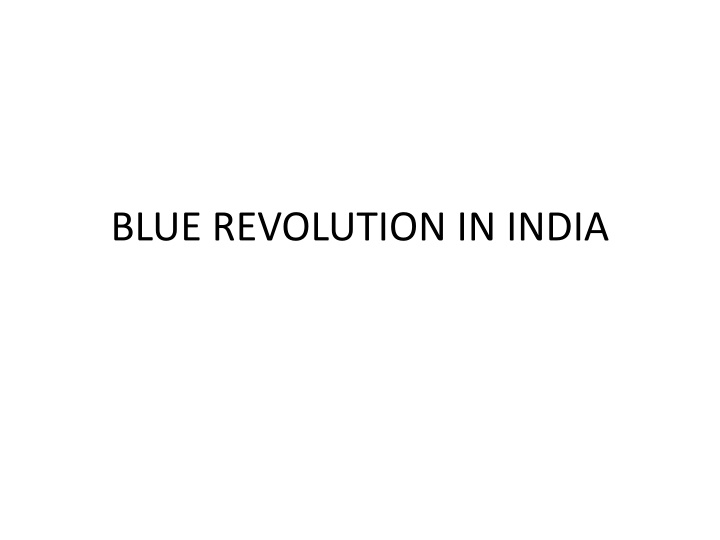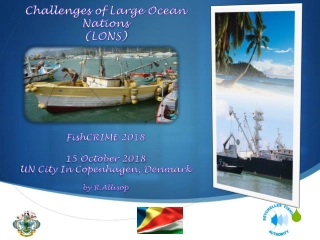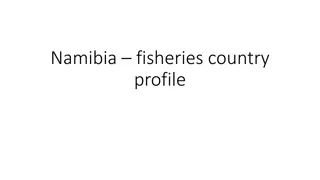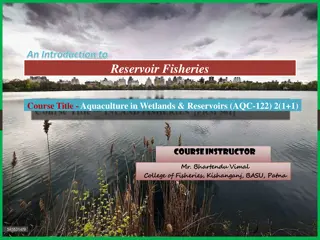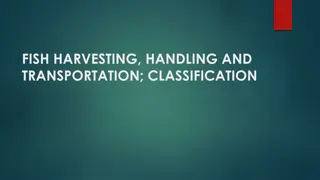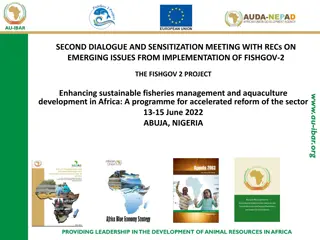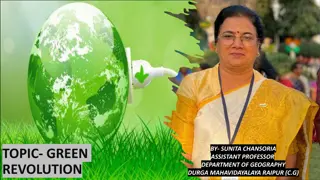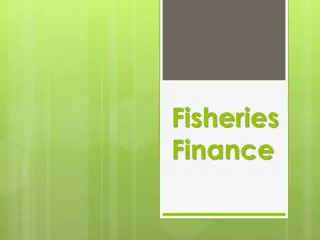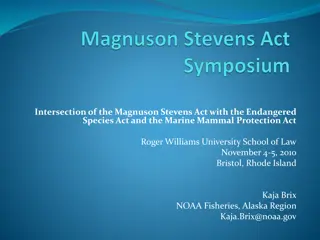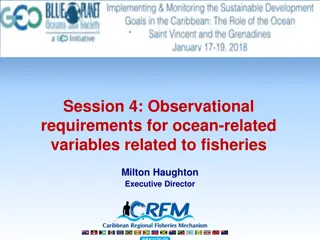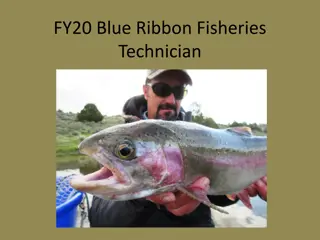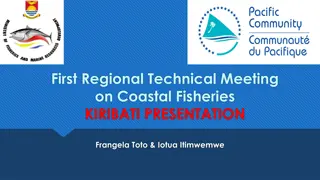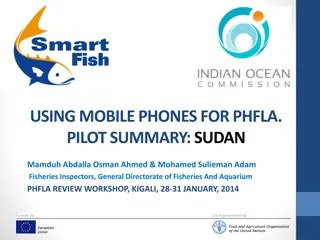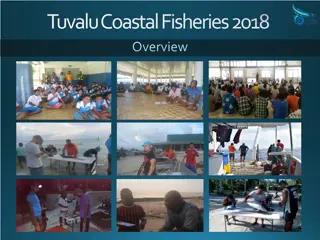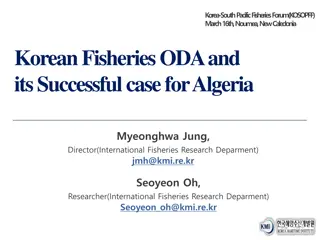The Blue Revolution: Transforming India's Fisheries Sector
The Blue Revolution in India refers to the significant increase in fish and marine product production through innovative techniques and government-sponsored programs. Launched during the 7th Five-Year Plan, it has revolutionized aquaculture practices, leading to improved breeding, rearing, marketing, and export opportunities. Key aspects include mechanical development, aquaculture promotion, and marketing facilities. The initiative has established fishing harbors, research centers, and collaboration with multinational companies to enhance marine fisheries. Aquaculture has emerged as a lucrative agricultural activity, stimulating economic development, generating income and employment, and providing vital nutrition and livelihoods to many.
Download Presentation

Please find below an Image/Link to download the presentation.
The content on the website is provided AS IS for your information and personal use only. It may not be sold, licensed, or shared on other websites without obtaining consent from the author.If you encounter any issues during the download, it is possible that the publisher has removed the file from their server.
You are allowed to download the files provided on this website for personal or commercial use, subject to the condition that they are used lawfully. All files are the property of their respective owners.
The content on the website is provided AS IS for your information and personal use only. It may not be sold, licensed, or shared on other websites without obtaining consent from the author.
E N D
Presentation Transcript
The concept of rapid increase in the production of fish and marine product through package programme is called as Blue Revolution . It was launched in India during the 7th Five year plan ( 1985- 1990 ) when the Central Government sponsored the Fish Farmers Development Agency ( FFDA ) . It has brought improvement in aquaculture by adopting new techniques of fish breeding, fish rearing , fish marketing and fish export . Andhra Pradesh and Tamil Nadu have developed shrimp in a big way . The Nellore District of Andhra is known as the Shrimp Capital of India . There are more than 1800 species of fish found in the sea and inland waters of India , Among them a very few are commercially important .
The important sea fish include Catfish , Indian Salmon , Shell fish , Eels , Anchovies and Dorab . Essentials of Blue Revolution 1. Mechanical and technical development 2. Encouragement to Aquaculture ( Fish Farming ) 3. Facility of operative and marketing . During the 8th Five year plan ( 1992 97 ), the intensive marine fisheries programme was launched in which collaboration with multinational companies was encouraged . Several fishing harbours were established during the Blue Revolution e.g. Tuticorin , Porbandar , Honavar , Vishakhapatnam , Kochi , Port Blair etc .
Number of research centre were set up to increase the production and improvement in species For freshwater fish Barrack pore (Kolkatta ) For marine fish Mandapam ( Tamil Nadu and Mumbai ) Central Fish Research Centre Mumbai Central institute of Fisheries and Nautical Engineering Training Kochi
The term Blue Revolution refers to the remarkable emergence of Aquaculture As an important and highly productive agricultural activity . Aquaculture refers to all forms of active culturing of aquatic animals and plants occurring in marine , brackish , or fresh water. Aquaculture has long been practiced in China and other places in Asia , where freshwater have been grown a food in managed ponds for thousands of years .
Fisheries sector occupies a very important place in the Socio- Economic development of the country . It has been recognized as a powerful income and employment generator as it stimulates growth of a number of subsidiary industries and is a source of cheap and nutritious food besides being a foreign exchange earner . Most importantly , it is the source of livelihood for a large section of economically backward population of the country .
India is one of the largest producers of fish in the world . As coastline stretches for 6100 Km . India has vast marine fish resources . In Coastal areas fishing is a traditional occupation and now new inland fisheries are developed . Inland fisheries is an important rural activity catering to the domestic market and giving gainful employment for over 1. 75 millions persons . Fishery sector in India as a whole has been providing employment to about 59.60 lakhs full time or part time fishermen . In addition another six million people are engaged in fishery related ancillary activities .
Total fish production rose from 3.5 lakhs tonnes in 1948- 49 to 56. 56 lakhs tones in 2000- 2001 comprising 28.11 lakhs tones of marine fish and 28.45 lakhs tones of inland fish . Fisheries is a state subject and as such the primary responsibility for development rests with the State Governments. The major thrust in fisheries development has been on optimizing production and productivity , export of marine products , generating employment and improving welfare of fishermen and their Socio- economic status .
Impact of Blue Revolution Aquaculture provides manty benefits to people , mostly through access to a large production of nutritious , high quality foods . However , as with terrestrial agriculture , there are adverse environmental impacts of aquaculture These and other environmental effects of aquaculture are important considerations .
The White Revolution in India In India , Milk is obtained from Cows , Buffaloes , Goats and from Camels ( in Rajasthan ) The Indian Dairy Industry has acquired substantial growth from the 8TH plan onwards . India s milk output has not only placed the Industry first in the world , but also represents sustained growth in the availability of Milk and Miik products . The Dairy sector is now the largest contributer in the agricultural sector to the nation s GDP. The huge increase in milk supply through the efforts on a cooperative level is known as the White Revolution .
Operation Food Success in raising the milk production is ascribed to the Operation Food Project In 1965 , the National Dairy Development Board was set up to promote , plan and organise dairy development through cooperatives . These cooperatives were envisaged as democratic institutions , owned and managed by rural producer s demands . The NDDB launched Operation Food in 1970 with commodity gifts from the European Community , which included Skimmed milk powder and butter oil Operation Food is considered to be the world s largest dairy development Programme . Under this programme professionals were employed at every level . Particularly in marketing and application , and Science and technology .
Phase 1 It started in July 1970 and ended in 1981 . The objective was to set up Dairy Cooperatives in 18 milk sheds in ten states , So as to link them with the four best metropolitan markets of Mumbai , Delhi , Kolkata and Chennai . By the end of Phase 1 , there were 13,000 village dairy cooperatives covering 15 Lakh farmer families Phase 2 It covered the 6th plan period from 1981 to 1985 . It was designed to build on the foundations of phase -1 By the end of phase -2 there were 136 milk sheds , 34,500 village dairy cooperatives covering 36 lakh members .
Phase -3 It started in 1985 .by improving productivity and efficiency of the cooperatives dairy sector and its institutional base for long term sustainability . This phase came to an end in April 1996 . By September , 1996 ,about about 73,300 dairy cooperative societies had been organised in 170 milk sheds involving over 9.4 million farmer members . Outstanding Results 1. The milk production in India incresed from a level of 17 MT in 1950 -51 to about 100,9 MT at the end of 2006- 07 , I,e . At the end of the Tenth Plan 2. The per capita availability of milk increased to about 246 gm per day in 2006- 07 from a level of 124 gm per day in 1950- 51 3. Imports of milk solids have ended . India has also started exporting milk powder to some countries now .
4. Dairy industry and infrastructure have been expanded and modernised . A milk Grid has been activated to offset regional and seasonal imbalances in milk production . A stable structure is now present to protect against political instability . 5. About ten million small farmers in 70,000 villages are earning jointly an incremental income of more than Rs. 2000 crore and more than 60 per cent of the milk production for Operation Flood comes from small , marginal farmers and the landless . 6. Most of the dairy needs are met indigenously . ______+____
